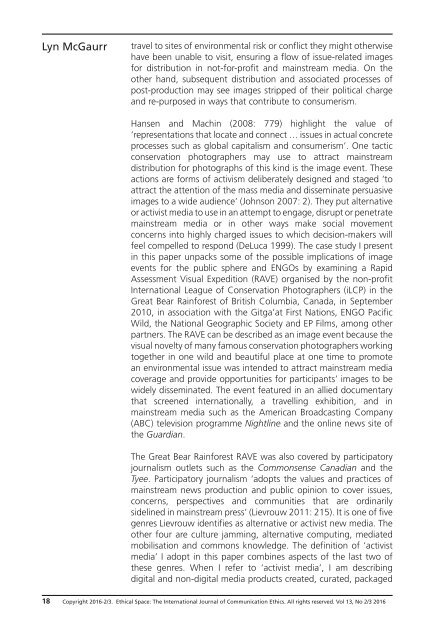Beyond clickbait and commerce
v13n2-3
v13n2-3
You also want an ePaper? Increase the reach of your titles
YUMPU automatically turns print PDFs into web optimized ePapers that Google loves.
Lyn McGaurr<br />
travel to sites of environmental risk or conflict they might otherwise<br />
have been unable to visit, ensuring a flow of issue-related images<br />
for distribution in not-for-profit <strong>and</strong> mainstream media. On the<br />
other h<strong>and</strong>, subsequent distribution <strong>and</strong> associated processes of<br />
post-production may see images stripped of their political charge<br />
<strong>and</strong> re-purposed in ways that contribute to consumerism.<br />
Hansen <strong>and</strong> Machin (2008: 779) highlight the value of<br />
‘representations that locate <strong>and</strong> connect … issues in actual concrete<br />
processes such as global capitalism <strong>and</strong> consumerism’. One tactic<br />
conservation photographers may use to attract mainstream<br />
distribution for photographs of this kind is the image event. These<br />
actions are forms of activism deliberately designed <strong>and</strong> staged ‘to<br />
attract the attention of the mass media <strong>and</strong> disseminate persuasive<br />
images to a wide audience’ (Johnson 2007: 2). They put alternative<br />
or activist media to use in an attempt to engage, disrupt or penetrate<br />
mainstream media or in other ways make social movement<br />
concerns into highly charged issues to which decision-makers will<br />
feel compelled to respond (DeLuca 1999). The case study I present<br />
in this paper unpacks some of the possible implications of image<br />
events for the public sphere <strong>and</strong> ENGOs by examining a Rapid<br />
Assessment Visual Expedition (RAVE) organised by the non-profit<br />
International League of Conservation Photographers (iLCP) in the<br />
Great Bear Rainforest of British Columbia, Canada, in September<br />
2010, in association with the Gitga’at First Nations, ENGO Pacific<br />
Wild, the National Geographic Society <strong>and</strong> EP Films, among other<br />
partners. The RAVE can be described as an image event because the<br />
visual novelty of many famous conservation photographers working<br />
together in one wild <strong>and</strong> beautiful place at one time to promote<br />
an environmental issue was intended to attract mainstream media<br />
coverage <strong>and</strong> provide opportunities for participants’ images to be<br />
widely disseminated. The event featured in an allied documentary<br />
that screened internationally, a travelling exhibition, <strong>and</strong> in<br />
mainstream media such as the American Broadcasting Company<br />
(ABC) television programme Nightline <strong>and</strong> the online news site of<br />
the Guardian.<br />
The Great Bear Rainforest RAVE was also covered by participatory<br />
journalism outlets such as the Commonsense Canadian <strong>and</strong> the<br />
Tyee. Participatory journalism ‘adopts the values <strong>and</strong> practices of<br />
mainstream news production <strong>and</strong> public opinion to cover issues,<br />
concerns, perspectives <strong>and</strong> communities that are ordinarily<br />
sidelined in mainstream press’ (Lievrouw 2011: 215). It is one of five<br />
genres Lievrouw identifies as alternative or activist new media. The<br />
other four are culture jamming, alternative computing, mediated<br />
mobilisation <strong>and</strong> commons knowledge. The definition of ‘activist<br />
media’ I adopt in this paper combines aspects of the last two of<br />
these genres. When I refer to ‘activist media’, I am describing<br />
digital <strong>and</strong> non-digital media products created, curated, packaged<br />
18 Copyright 2016-2/3. Ethical Space: The International Journal of Communication Ethics. All rights reserved. Vol 13, No 2/3 2016


